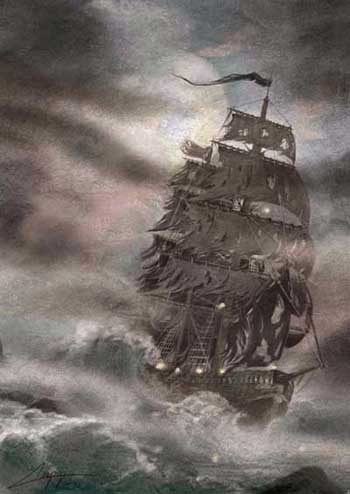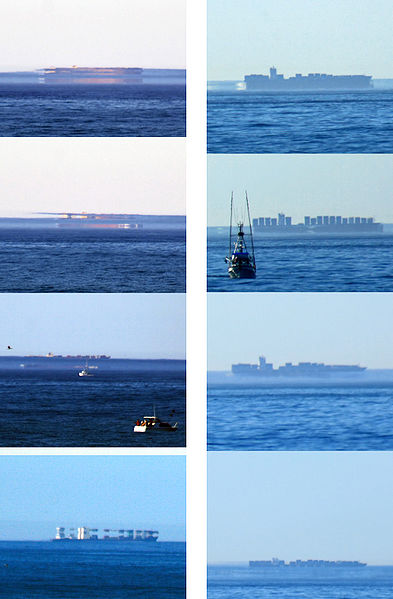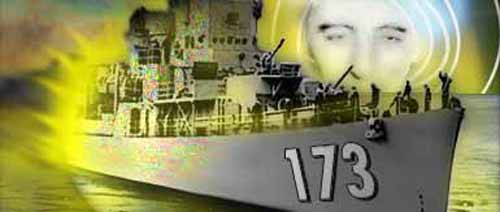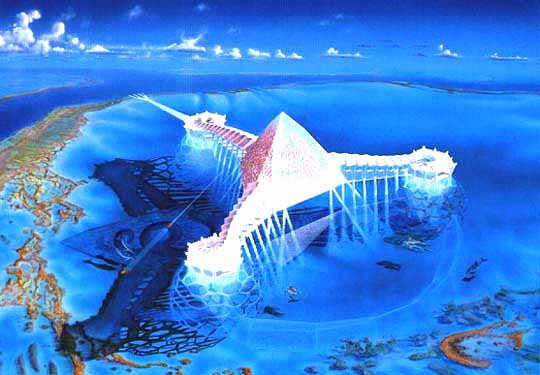
July 11, 2011
We all know that several people can view the same event, each person describing it differently based on their brain's programming. Simulation - one that never stops changing allowing viewers to experience in linear time and emotionally interpret what they see ... but alas none of it real.
I find that hot weather greatly increases the chances of seeing an optical illusion, explained in connection with the sea as a Fata Morgana. But first let's time travel back to this date 130 years ago and meet another member of the British royal family, Prince George, (later King George V) - whose throne will one day go to Prince William.

It was July 11, 1881, when George, Prince of Wales, a 16-year-old naval cadet on the HMS Inconstant off the Australian coast, stood looking out to sea, mesmerized by a strange glowing ship that past in the night. He later wrote in his log book:
According to folklore, the Flying Dutchman is a ghost ship that can never go home, but must sail "the seven seas" forever. It is usually spotted from afar, sometimes glowing with ghostly light. If she is hailed by another ship, her crew will often try to send messages to land, to people long since dead. Versions of the story are numerous. The oldest extant version dates to the late 18th century. Sightings in the 19th and 20th centuries report the ship to be glowing with ghostly light. In ocean lore, the sight of this phantom ship is a portent of doom.
Some have noted a resemblance of the Flying Dutchman legend to the Christian folk tale of the Wandering Jew who taunted Jesus on the way to the Crucifixion and was then cursed to walk the earth until the Second Coming - or the end of the program.

Probably the most credible explanation for what young George saw is a superior mirage or Fata Morgana seen at sea. A Fata Morgana is an unusual and very complex form of mirage, a form of superior mirage, which, like many other kinds of superior mirages, is seen in a narrow band right above the horizon. It is an Italian phrase derived from the vulgar Latin for "fairy" and the Arthurian sorcerer Morgan le Fay, from a belief that the mirage, often seen in the Strait of Messina, were fairy castles in the air or false land designed to lure sailors to their death created by her witchcraft. Although the term Fata Morgana is sometimes incorrectly applied to other, more common kinds of mirages, the true Fata Morgana is not the same as an ordinary superior mirage, and is certainly not the same as an inferior mirage.
Fata Morgana mirages tremendously distort the object or objects which they are based on, such that the object often appears to be very unusual, and may even be transformed in such a way that it is completely unrecognizable. A Fata Morgana can be seen on land or at sea, in polar regions or in deserts. This kind of mirage can involve almost any kind of distant object, including such things as boats, islands, and coastline, as shown in the photographs which accompany this article.
A Fata Morgana is not only complex, but also rapidly changing. The mirage comprises several inverted (upside down) and erect (right side up) images that are stacked on top of one another. Fata Morgana mirages also show alternating compressed and stretched zones
This optical phenomenon occurs because rays of light are strongly bent when they pass through air layers of different temperatures in a steep thermal inversion where an atmospheric duct has formed. (A thermal inversion is an atmospheric condition where warmer air exists in a well-defined layer above a layer of significantly cooler air. This temperature inversion is the opposite of what is normally the case; air is usually warmer close to the surface, and cooler higher up.)
In calm weather, a layer of significantly warmer air can rest over colder dense air, forming an atmospheric duct which acts like a refracting lens, producing a series of both inverted and erect images. A Fata Morgana requires a duct to be present; thermal inversion alone is not enough to produce this kind of mirage. While a thermal inversion often takes place without there being an atmospheric duct, an atmospheric duct cannot exist without there first being a thermal inversion.
A Fata Morgana is most commonly seen in polar regions, especially over large sheets of ice which have a uniform low temperature. It can however be observed in almost any area. In polar regions the Fata Morgana phenomenon is observed on relatively cold days, however in deserts, over oceans, and over lakes, a Fata Morgana can be observed on hot days.
To generate the Fata Morgana phenomenon, the thermal inversion has to be strong enough that the curvature of the light rays within the inversion layer is stronger than the curvature of the Earth. Under these conditions, the rays bend and create arcs. An observer needs to be within or below an atmospheric duct in order to be able to see a Fata Morgana.
A Fata Morgana can be observed from any altitude within the Earth's atmosphere, from sea level up to mountain tops, and even including the view from airplanes.
A Fata Morgana can be described as a very complex superior mirage with more than three distorted erect and inverted images. Because of the constantly changing conditions of the atmosphere, a Fata Morgana can change in various ways within just a few seconds of time, including changing to become a straightforward superior mirage.
The sequential image here shows sixteen photographic frames of a mirage of the Farallon Islands as seen from San Francisco; the images were all taken on the same day.
In the first fourteen frames, elements of the Fata Morgana mirage display alternations of compressed and stretched zones. The last two frames were photographed few hours later, around sunset time. At that point in time, the air was cooler while the ocean was probably a little bit warmer, which caused the thermal inversion to be not as extreme as it was few hours before. A mirage was still present at that point, but it was not as complex as few hours before sunset: the mirage was no longer a Fata Morgana, but instead had become a simple superior mirage.
Fata Morgana mirages are visible to the naked eye, but in order to be able to see the detail within them, it is best to view them through binoculars, a telescope, or as is the case in the images here, through a telephoto lens.
The Philadelphia Experiment

USOs - Unidentified Submerged Objects